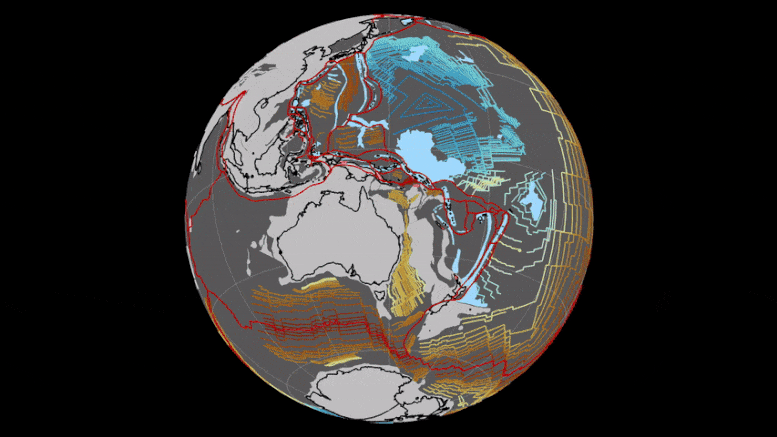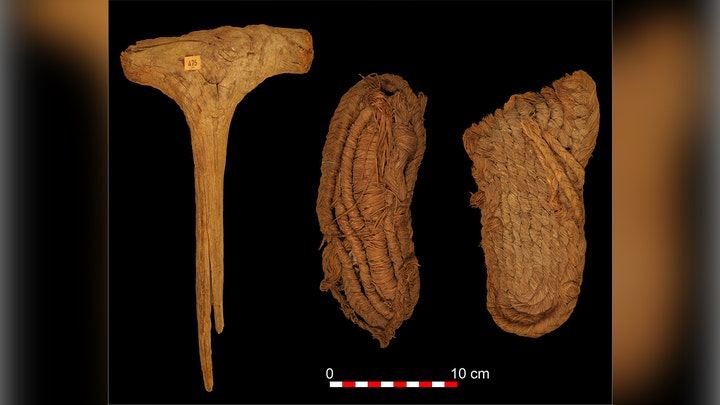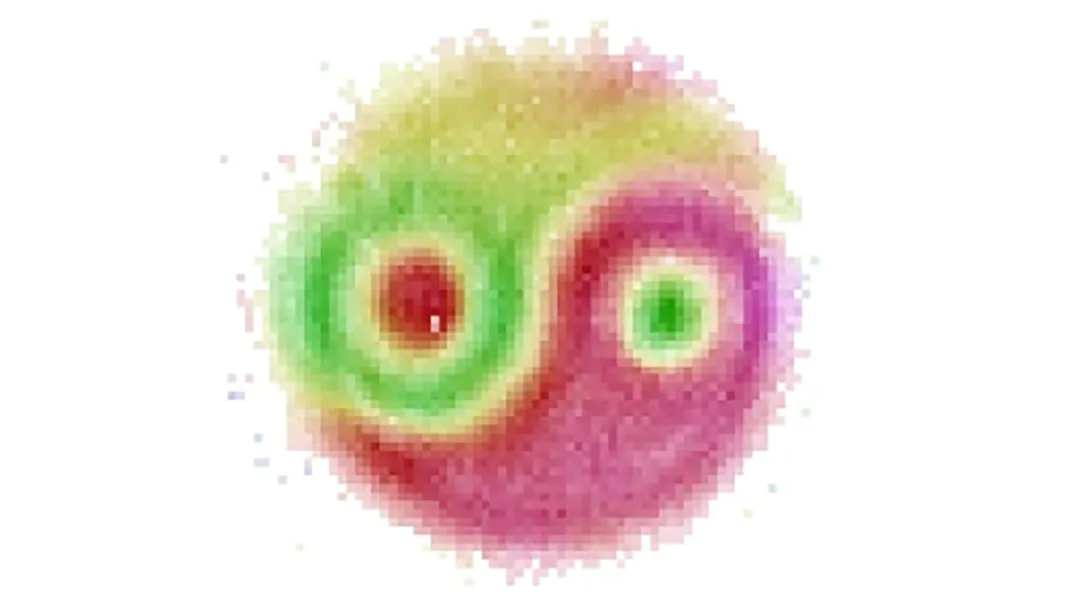Building Blocks of Life? NASA Reveals 4.5-Billion-Year-Old Asteroid Bennu Sample
Initial studies of the 4.5-billion-year-old asteroid Bennu sample collected in space and brought to Earth by NASA show evidence of high-carbon content and water, which together could indicate the building blocks of life on Earth may be found in the rock.
BELOW: A view of the outside of the OSIRIS-REx sample collector. Sample material from asteroid Bennu can be seen on the middle right.

https://scitechdaily.com/building-bl...-bennu-sample/
Initial studies of the 4.5-billion-year-old asteroid Bennu sample collected in space and brought to Earth by NASA show evidence of high-carbon content and water, which together could indicate the building blocks of life on Earth may be found in the rock.
BELOW: A view of the outside of the OSIRIS-REx sample collector. Sample material from asteroid Bennu can be seen on the middle right.

https://scitechdaily.com/building-bl...-bennu-sample/
So you should view this fleeting world --
A star at dawn, a bubble in a stream ...
A star at dawn, a bubble in a stream ...
Supernova Bubble Captured in Hubble Time-Lapse Movie – 20,000-Year-Old Explosion Still Expanding at 500,000 MPH
A blink between Hubble images taken in 2001 (with Wide Field Planetary Camera 2 (WFPC2)) and 2020 (with Wide Field Camera 3 (WFC3)) shows gossamer filaments of glowing hydrogen in orange and cooling ionized oxygen in blue. The hydrogen filaments resemble lines in a wrinkled bedsheet seen from the side. The wrinkles arise as the shock wave encounters more or less dense material in the interstellar medium. Analyzing the shock wave’s location, astronomers found that the filaments have not slowed down at all in the last 20 years of Hubble observations, and they haven’t changed shape. The material is speeding into interstellar space at over half a million miles per hour—fast enough to travel from Earth to the Moon in less than half an hour. The shock wave is moving toward the top of these images.
https://scitechdaily.com/supernova-b...at-500000-mph/
A blink between Hubble images taken in 2001 (with Wide Field Planetary Camera 2 (WFPC2)) and 2020 (with Wide Field Camera 3 (WFC3)) shows gossamer filaments of glowing hydrogen in orange and cooling ionized oxygen in blue. The hydrogen filaments resemble lines in a wrinkled bedsheet seen from the side. The wrinkles arise as the shock wave encounters more or less dense material in the interstellar medium. Analyzing the shock wave’s location, astronomers found that the filaments have not slowed down at all in the last 20 years of Hubble observations, and they haven’t changed shape. The material is speeding into interstellar space at over half a million miles per hour—fast enough to travel from Earth to the Moon in less than half an hour. The shock wave is moving toward the top of these images.
https://scitechdaily.com/supernova-b...at-500000-mph/
NASA’s Webb Reveals Breathtaking Glimpse of Star Birth in Ethereal Depths
This video compares images of star-forming region NGC 346 taken in visible light with the Hubble Space Telescope’s ACS instrument, near-infrared with the James Webb Space Telescope’s NIRCam instrument, and mid-infrared with Webb’s MIRI instrument. Hubble’s visible-light image is filled with thousands of stars, as well as curtains of hydrogen and oxygen gas colored blue. In Webb’s near-infrared image, pink represents energized hydrogen, while orange represents dense, molecular hydrogen. Webb’s mid-infrared image highlights bright patches of star formation, diffuse pink emission from warm dust, and blue filaments of dusty and sooty material. ... The field of view shown in this image is approximately 150 light-years across. ...
https://scitechdaily.com/nasas-webb-...hereal-depths/
This video compares images of star-forming region NGC 346 taken in visible light with the Hubble Space Telescope’s ACS instrument, near-infrared with the James Webb Space Telescope’s NIRCam instrument, and mid-infrared with Webb’s MIRI instrument. Hubble’s visible-light image is filled with thousands of stars, as well as curtains of hydrogen and oxygen gas colored blue. In Webb’s near-infrared image, pink represents energized hydrogen, while orange represents dense, molecular hydrogen. Webb’s mid-infrared image highlights bright patches of star formation, diffuse pink emission from warm dust, and blue filaments of dusty and sooty material. ... The field of view shown in this image is approximately 150 light-years across. ...
https://scitechdaily.com/nasas-webb-...hereal-depths/
Revolutionary “New Lens” Into the Universe’s Most Energetic Particles
Scientists from Osaka Metropolitan University have harnessed the Subaru Telescope to observe cosmic-ray showers with unprecedented clarity. This new method could lead to profound discoveries about the Universe, including insights into dark matter. ...
... When a high-energy cosmic ray collides with the Earth’s atmosphere, it generates an enormous number of particles known as an extensive air shower. ...
BELOW: An example of a cosmic-ray extensive air shower recorded by the Subaru Telescope. The highlighted tracks, which are mostly aligned in similar directions, show the shower particles induced from a high-energy cosmic ray.
 https://scitechdaily.com/revolutiona...tic-particles/
https://scitechdaily.com/revolutiona...tic-particles/
Scientists from Osaka Metropolitan University have harnessed the Subaru Telescope to observe cosmic-ray showers with unprecedented clarity. This new method could lead to profound discoveries about the Universe, including insights into dark matter. ...
... When a high-energy cosmic ray collides with the Earth’s atmosphere, it generates an enormous number of particles known as an extensive air shower. ...
BELOW: An example of a cosmic-ray extensive air shower recorded by the Subaru Telescope. The highlighted tracks, which are mostly aligned in similar directions, show the shower particles induced from a high-energy cosmic ray.

Understanding Attoseconds: The Tiny Time Scale Behind Nobel Prize-Winning Research
The 2023 Nobel Prize in physics recognized three researchers for their work with attosecond light pulses, revolutionizing the study of rapid electron movements and broadening understanding in various fields of physics and chemistry.
“Atto” is the scientific notation prefix that represents 10-18, which is a decimal point followed by 17 zeroes and a 1. So a flash of light lasting an attosecond, or 0.000000000000000001 of a second, is an extremely short pulse of light.
In fact, there are approximately as many attoseconds in one second as there are seconds in the age of the universe.
https://scitechdaily.com/understandi...ning-research/
The 2023 Nobel Prize in physics recognized three researchers for their work with attosecond light pulses, revolutionizing the study of rapid electron movements and broadening understanding in various fields of physics and chemistry.
“Atto” is the scientific notation prefix that represents 10-18, which is a decimal point followed by 17 zeroes and a 1. So a flash of light lasting an attosecond, or 0.000000000000000001 of a second, is an extremely short pulse of light.
In fact, there are approximately as many attoseconds in one second as there are seconds in the age of the universe.
https://scitechdaily.com/understandi...ning-research/
One-Millionth of One-Millionth of a Second – Scientists View the “Transition State” of a Photochemical Reaction in Real-Time
Scientists used ultrafast electron diffraction to image the structure of the pericyclic minimum, the “transition state” of electrocyclic reactions.
In chemical reactions, molecules proceed during their transformation from reactants into reaction products through a critical geometry. In chemistry, geometry refers to the arrangement of atoms in a molecule. Scientists often call critical geometry in reactions a transition state. This state has an almost incomprehensibly short lifetime of less than one-millionth of one-millionth of a second.
BELOW: Artist’s illustration of the observed photochemical “transition state” structure (center).

https://scitechdaily.com/one-million...-in-real-time/
Scientists used ultrafast electron diffraction to image the structure of the pericyclic minimum, the “transition state” of electrocyclic reactions.
In chemical reactions, molecules proceed during their transformation from reactants into reaction products through a critical geometry. In chemistry, geometry refers to the arrangement of atoms in a molecule. Scientists often call critical geometry in reactions a transition state. This state has an almost incomprehensibly short lifetime of less than one-millionth of one-millionth of a second.
BELOW: Artist’s illustration of the observed photochemical “transition state” structure (center).

https://scitechdaily.com/one-million...-in-real-time/
Surprising Tectonic Discovery: Geologist Unexpectedly Finds Remnants of a Lost Mega-Plate
A geologist has successfully reconstructed a previously unknown tectonic plate named Pontus, once approximately one-fourth the size of the Pacific Ocean. This discovery was made through field research in various regions, including Japan, Borneo, and the Philippines.

A geologist has successfully reconstructed a previously unknown tectonic plate named Pontus, once approximately one-fourth the size of the Pacific Ocean. This discovery was made through field research in various regions, including Japan, Borneo, and the Philippines.

It is said that this little girl will be largely fine, leading a very normal life ...
Gene-edited pig kidney keeps monkey alive for 2 years, trial finds, a step toward longer-lasting human transplants
The scientists genetically modified the pigs so their kidneys could be transferred to another species and to improve the chances that the organs wouldn’t be rejected. Even when a human donates an organ to another human, the recipient has to take drugs to suppress their immune system for the rest of their lives so their body does not reject the donor organ.
With previous pig-to-primate donation experiments, even those involving genetically modified pigs, scientists had to use a significant number of immunosuppressant drugs, meaning the experiments would not be translatable to a human organ donation experiment, researchers said. But with this trial, the genetic modifications were effective enough that they needed only about as much medicine as a human could tolerate.
The team transplanted pig kidneys into more than 20 monkeys, although not all of the pigs had all of the gene edits.
None of the monkeys that got kidneys from the pigs without the seven human genes survived more than 50 days. The monkeys that got the full combination lived a lot longer: Five lived for more than a year, and one lived for more than two. Tests showed that the single donated kidney seemed to perform as well as two natural kidneys.
The scientists genetically modified the pigs so their kidneys could be transferred to another species and to improve the chances that the organs wouldn’t be rejected. Even when a human donates an organ to another human, the recipient has to take drugs to suppress their immune system for the rest of their lives so their body does not reject the donor organ.
With previous pig-to-primate donation experiments, even those involving genetically modified pigs, scientists had to use a significant number of immunosuppressant drugs, meaning the experiments would not be translatable to a human organ donation experiment, researchers said. But with this trial, the genetic modifications were effective enough that they needed only about as much medicine as a human could tolerate.
The team transplanted pig kidneys into more than 20 monkeys, although not all of the pigs had all of the gene edits.
None of the monkeys that got kidneys from the pigs without the seven human genes survived more than 50 days. The monkeys that got the full combination lived a lot longer: Five lived for more than a year, and one lived for more than two. Tests showed that the single donated kidney seemed to perform as well as two natural kidneys.
Shaking Up Predictions: Deep Learning Revolutionizes Earthquake Forecasts
Scientists have developed a deep learning model, RECAST, to forecast earthquake aftershocks. This model demonstrates superior adaptability and scalability compared to the existing ETAS model, especially with larger seismological datasets. The model could lead to improved forecasts, even in areas with limited data, by leveraging information from multiple global regions.
https://scitechdaily.com/shaking-up-...ake-forecasts/
Scientists have developed a deep learning model, RECAST, to forecast earthquake aftershocks. This model demonstrates superior adaptability and scalability compared to the existing ETAS model, especially with larger seismological datasets. The model could lead to improved forecasts, even in areas with limited data, by leveraging information from multiple global regions.
https://scitechdaily.com/shaking-up-...ake-forecasts/
EVEscape: The AI Revolution in Forecasting Viral Variants Before They Emerge
New AI tool called EVEscape uses evolutionary and biological information to predict how a virus could change to escape the immune system. The tool successfully predicted the most concerning new variants that occurred during the COVID-19 pandemic. Researchers say the tool can help inform the development of vaccines and therapies for SARS-CoV-2 and other rapidly mutating viruses.
https://scitechdaily.com/evescape-th...e-they-emerge/
New AI tool called EVEscape uses evolutionary and biological information to predict how a virus could change to escape the immune system. The tool successfully predicted the most concerning new variants that occurred during the COVID-19 pandemic. Researchers say the tool can help inform the development of vaccines and therapies for SARS-CoV-2 and other rapidly mutating viruses.
https://scitechdaily.com/evescape-th...e-they-emerge/
New proteins, better batteries: Scientists are using AI to speed up discoveries
On Thursday, the U.S. National Academies convened a two-day meeting on the potential for AI to change science. "AI scientists can really be more systematic, more comprehensive and not make errors," says Yolanda Gil, director of AI and data science initiatives at the Information Sciences Institute at the University of Southern California, who is attending the event.
Rather than using AI to do all science, she envisions a future in which AI systems plan and execute experiments, in collaboration with their human counterparts. In a world facing increasingly complex technical challenges, "there's not enough humans to do all this work," she says.
https://www.npr.org/sections/health-...ns-drugs-solar
On Thursday, the U.S. National Academies convened a two-day meeting on the potential for AI to change science. "AI scientists can really be more systematic, more comprehensive and not make errors," says Yolanda Gil, director of AI and data science initiatives at the Information Sciences Institute at the University of Southern California, who is attending the event.
Rather than using AI to do all science, she envisions a future in which AI systems plan and execute experiments, in collaboration with their human counterparts. In a world facing increasingly complex technical challenges, "there's not enough humans to do all this work," she says.
https://www.npr.org/sections/health-...ns-drugs-solar
AI-Powered Lasers: A Modern Solution to Space Debris
Hang Woon Lee, director of the Space Systems Operations Research Laboratory at WVU, said a junkyard of human-made debris, including defunct satellites, is accumulating around Earth. The more debris in orbit, the higher the risk that some of that debris will collide with manned and unmanned space assets. He said he believes the best chance for preventing those collisions is an array of multiple lasers mounted to platforms in space. The artificial intelligence-powered lasers could maneuver and work together to respond rapidly to debris of any size.

https://scitechdaily.com/ai-powered-...-space-debris/
Hang Woon Lee, director of the Space Systems Operations Research Laboratory at WVU, said a junkyard of human-made debris, including defunct satellites, is accumulating around Earth. The more debris in orbit, the higher the risk that some of that debris will collide with manned and unmanned space assets. He said he believes the best chance for preventing those collisions is an array of multiple lasers mounted to platforms in space. The artificial intelligence-powered lasers could maneuver and work together to respond rapidly to debris of any size.

https://scitechdaily.com/ai-powered-...-space-debris/
Jevons’ Paradox: AI Could Use As Much Electricity As Entire Countries
Generative AI models, like OpenAI’s ChatGPT, consume large amounts of energy during training and operational use. While global efforts are underway to improve AI’s energy efficiency, the increased efficiency might inadvertently boost demand due to Jevons’ Paradox. Given current projections, AI’s electricity consumption could rival that of entire nations by 2027. The researchers stress the importance of mindful AI application due to its energy-intensive nature. ...
https://scitechdaily.com/jevons-para...ire-countries/
Generative AI models, like OpenAI’s ChatGPT, consume large amounts of energy during training and operational use. While global efforts are underway to improve AI’s energy efficiency, the increased efficiency might inadvertently boost demand due to Jevons’ Paradox. Given current projections, AI’s electricity consumption could rival that of entire nations by 2027. The researchers stress the importance of mindful AI application due to its energy-intensive nature. ...
https://scitechdaily.com/jevons-para...ire-countries/
AI Game-Changer: Nanoelectronic Devices Uses 100x Less Energy
Northwestern University’s new nanoelectronic device offers energy-efficient, real-time AI tasks without relying on the cloud. Ideal for wearables, it processes data instantly and diagnosed heart conditions with 95% accuracy in tests. This innovation promises faster, efficient, and private health monitoring.
... With its tiny footprint, ultra-low power consumption, and lack of lag time to receive analyses, the device is ideal for direct incorporation into wearable electronics (like smartwatches and fitness trackers) for real-time data processing and near-instant diagnostics.
“Today, most sensors collect data and then send it to the cloud, where the analysis occurs on energy-hungry servers before the results are finally sent back to the user,” said Northwestern’s Mark C. Hersam, the study’s senior author. “This approach is incredibly expensive, consumes significant energy and adds a time delay. Our device is so energy efficient that it can be deployed directly in wearable electronics for real-time detection and data processing, enabling more rapid intervention for health emergencies.”
https://scitechdaily.com/ai-game-cha...x-less-energy/
Northwestern University’s new nanoelectronic device offers energy-efficient, real-time AI tasks without relying on the cloud. Ideal for wearables, it processes data instantly and diagnosed heart conditions with 95% accuracy in tests. This innovation promises faster, efficient, and private health monitoring.
... With its tiny footprint, ultra-low power consumption, and lack of lag time to receive analyses, the device is ideal for direct incorporation into wearable electronics (like smartwatches and fitness trackers) for real-time data processing and near-instant diagnostics.
“Today, most sensors collect data and then send it to the cloud, where the analysis occurs on energy-hungry servers before the results are finally sent back to the user,” said Northwestern’s Mark C. Hersam, the study’s senior author. “This approach is incredibly expensive, consumes significant energy and adds a time delay. Our device is so energy efficient that it can be deployed directly in wearable electronics for real-time detection and data processing, enabling more rapid intervention for health emergencies.”
https://scitechdaily.com/ai-game-cha...x-less-energy/
AI Empathy: Is It Technology or Just Our Perceptions?
Study shows users can be primed to believe certain things about an AI chatbot’s motives, which influences their interactions with the chatbot. ... Researchers from MIT and Arizona State University found that priming users — by telling them that a conversational AI agent for mental health support was either empathetic, neutral, or manipulative — influenced their perception of the chatbot and shaped how they communicated with it, even though they were speaking to the exact same chatbot. ... Most users who were told the AI agent was caring believed that it was, and they also gave it higher performance ratings than those who believed it was manipulative. At the same time, less than half of the users who were told the agent had manipulative motives thought the chatbot was actually malicious, indicating that people may try to “see the good” in AI the same way they do in their fellow humans.
Study shows users can be primed to believe certain things about an AI chatbot’s motives, which influences their interactions with the chatbot. ... Researchers from MIT and Arizona State University found that priming users — by telling them that a conversational AI agent for mental health support was either empathetic, neutral, or manipulative — influenced their perception of the chatbot and shaped how they communicated with it, even though they were speaking to the exact same chatbot. ... Most users who were told the AI agent was caring believed that it was, and they also gave it higher performance ratings than those who believed it was manipulative. At the same time, less than half of the users who were told the agent had manipulative motives thought the chatbot was actually malicious, indicating that people may try to “see the good” in AI the same way they do in their fellow humans.
Emotional Bytes: Can AI Crave a Favorite Food?
Penn State researchers are developing an electronic tongue that simulates the human process of gustation, which could influence AI to make decisions more like humans. This innovation is part of an effort to incorporate the emotional intelligence aspect, often overlooked in AI research. This electronic gustatory system can currently detect all five primary tastes and has numerous potential applications, from AI-driven diets to personalized restaurant offerings. ... Electronic tongue’ holds promise as possible first step to artificial emotional intelligence.
https://scitechdaily.com/emotional-b...favorite-food/
Penn State researchers are developing an electronic tongue that simulates the human process of gustation, which could influence AI to make decisions more like humans. This innovation is part of an effort to incorporate the emotional intelligence aspect, often overlooked in AI research. This electronic gustatory system can currently detect all five primary tastes and has numerous potential applications, from AI-driven diets to personalized restaurant offerings. ... Electronic tongue’ holds promise as possible first step to artificial emotional intelligence.
https://scitechdaily.com/emotional-b...favorite-food/
Scientists Debunk the Myth: Do Trees Really Have Feelings?
Researchers scrutinized claims made in two popular books about trees having human-like traits and emotions. Published in Trends in Plant Science, their findings challenge many of these claims as unscientific. They caution against anthropomorphizing plants and highlight issues like the flawed “mother tree concept” and the dangers of making decisions based on appealing but inaccurate narratives, especially in the context of climate change adaptation.
... The researchers report that in those works, trees are attributed with human characteristics and behaviors, including the ability to feel pain and pleasure, to communicate with one another, and to act altruistically. ...
... Finally, the authors point out the fatal consequences such claims could have for the adaptation of forests to climate change if political decisions are “based on pleasant-sounding but false messages” rather than scientific fact, adds Robinson. ...
https://scitechdaily.com/scientists-...have-feelings/
Researchers scrutinized claims made in two popular books about trees having human-like traits and emotions. Published in Trends in Plant Science, their findings challenge many of these claims as unscientific. They caution against anthropomorphizing plants and highlight issues like the flawed “mother tree concept” and the dangers of making decisions based on appealing but inaccurate narratives, especially in the context of climate change adaptation.
... The researchers report that in those works, trees are attributed with human characteristics and behaviors, including the ability to feel pain and pleasure, to communicate with one another, and to act altruistically. ...
... Finally, the authors point out the fatal consequences such claims could have for the adaptation of forests to climate change if political decisions are “based on pleasant-sounding but false messages” rather than scientific fact, adds Robinson. ...
https://scitechdaily.com/scientists-...have-feelings/
See Japanese 'ARCHAX' robot with $3 million price tag
The blimp is back – and this time, it’s tiny
South African startup Cloudline has received millions of dollars in investment for its mini blimps. Just over 18 meters (60 feet) long and with a miniscule net weight of two to three kilograms (around four to seven pounds), the company is pitching them as an alternative to helicopters and other vertical take-off and landing aircraft, and with payload capacities outstripping those of drones.
Cloudline has already received approval from local authorities to begin flying its airships in South Africa and is in talks with partners in Namibia, Mozambique and Kenya to begin operations, says CEO Spencer Horne.
The helium-filled blimps are fitted with solar panels and backup batteries to power their engines, have a flight time of up to 12 hours and a range of up to 400 kilometers (249 miles), flying at a height up to 1,220 meters (4,000 feet) above take-off level.
Flight is fully autonomous, with each blimp following predetermined waypoints. In the event an airship encounters an abnormality, it will reroute to a predetermined point and wait for instruction from a human, who has access to its telemetry data.
South African startup Cloudline has received millions of dollars in investment for its mini blimps. Just over 18 meters (60 feet) long and with a miniscule net weight of two to three kilograms (around four to seven pounds), the company is pitching them as an alternative to helicopters and other vertical take-off and landing aircraft, and with payload capacities outstripping those of drones.
Cloudline has already received approval from local authorities to begin flying its airships in South Africa and is in talks with partners in Namibia, Mozambique and Kenya to begin operations, says CEO Spencer Horne.
The helium-filled blimps are fitted with solar panels and backup batteries to power their engines, have a flight time of up to 12 hours and a range of up to 400 kilometers (249 miles), flying at a height up to 1,220 meters (4,000 feet) above take-off level.
Flight is fully autonomous, with each blimp following predetermined waypoints. In the event an airship encounters an abnormality, it will reroute to a predetermined point and wait for instruction from a human, who has access to its telemetry data.
Divergent DNA: The Accidental Discovery That’s Shaking Genetics
Researchers found an unexpected genetic variation in a new protist species, challenging established understanding of DNA-to-protein translation and emphasizing the mysteries that nature still holds. ...
https://scitechdaily.com/divergent-d...king-genetics/
Researchers found an unexpected genetic variation in a new protist species, challenging established understanding of DNA-to-protein translation and emphasizing the mysteries that nature still holds. ...
https://scitechdaily.com/divergent-d...king-genetics/
Darwin’s Dilemma: “Paradox of Stasis” Lizard Study Challenges the Rules of Evolutionary Biology
By lassoing lizards, putting tiny chips on their legs, and tracking them for three years, Georgia Tech’s James Stroud revealed why species often appear unchanged for millions of years despite Charles Darwin’s theory of constant evolution. ...
To his surprise, Stroud found that the stabilizing form of natural selection — that which maintains a species’ same, average features — was extremely rare. In fact, natural selection varied massively through time. Some years, lizards with longer legs would survive better, and other years, lizards with shorter legs fared better. For other times, there was no clear pattern at all. “The most fascinating result is that natural selection was extremely variable through time,” Stroud said. “We often saw that selection would completely flip in direction from one year to the next. When combined into a long-term pattern, however, all this variation effectively canceled itself out: Species remained remarkably similar across the entire time period.”
https://scitechdaily.com/darwins-dil...onary-biology/
By lassoing lizards, putting tiny chips on their legs, and tracking them for three years, Georgia Tech’s James Stroud revealed why species often appear unchanged for millions of years despite Charles Darwin’s theory of constant evolution. ...
To his surprise, Stroud found that the stabilizing form of natural selection — that which maintains a species’ same, average features — was extremely rare. In fact, natural selection varied massively through time. Some years, lizards with longer legs would survive better, and other years, lizards with shorter legs fared better. For other times, there was no clear pattern at all. “The most fascinating result is that natural selection was extremely variable through time,” Stroud said. “We often saw that selection would completely flip in direction from one year to the next. When combined into a long-term pattern, however, all this variation effectively canceled itself out: Species remained remarkably similar across the entire time period.”
https://scitechdaily.com/darwins-dil...onary-biology/
'Prehistoric footwear' was discovered in Spanish cave by miners, scientists reveal in new study
Some 20 pairs of sandals are said to be at least 6,200 years old
What may have been the oldest pair of shoes in Europe were discovered in a cave in Spain and are now thought to be much older than scientists previously thought.
About 20 pairs of the sandals are at least 6,200 years old — and possibly older — while other woven objects in the cave are dated back 9,500 years, according to a new study by scientists. The shoes measured around 20.5cm — or a little over 8 inches.
The news emerged after scientists used carbon-dating on 76 objects from the Cueva de los Murciélagos, Albuñol, near Granada, that had been dug out by miners in the 19th century.

https://www.foxnews.com/lifestyle/pr...entists-reveal
Some 20 pairs of sandals are said to be at least 6,200 years old
What may have been the oldest pair of shoes in Europe were discovered in a cave in Spain and are now thought to be much older than scientists previously thought.
About 20 pairs of the sandals are at least 6,200 years old — and possibly older — while other woven objects in the cave are dated back 9,500 years, according to a new study by scientists. The shoes measured around 20.5cm — or a little over 8 inches.
The news emerged after scientists used carbon-dating on 76 objects from the Cueva de los Murciélagos, Albuñol, near Granada, that had been dug out by miners in the 19th century.

https://www.foxnews.com/lifestyle/pr...entists-reveal
SpaceX fires back at FAA report suggesting its Starlink internet constellation could be deadly
The 35-page analysis, compiled in part by the nonprofit research group The Aerospace Corporation, offers a dire picture of the potential dangers associated with large networks of satellites such as Starlink, suggesting that by 2035, “if the expected large constellation growth is realized and debris from Starlink satellites survive reentry … one person on the planet would be expected to be injured or killed every two years.”
It also estimates that the probability of an aircraft being downed by a collision with falling space debris could be 0.0007 per year by 2035.

https://us.cnn.com/2023/10/10/world/...scn/index.html
The 35-page analysis, compiled in part by the nonprofit research group The Aerospace Corporation, offers a dire picture of the potential dangers associated with large networks of satellites such as Starlink, suggesting that by 2035, “if the expected large constellation growth is realized and debris from Starlink satellites survive reentry … one person on the planet would be expected to be injured or killed every two years.”
It also estimates that the probability of an aircraft being downed by a collision with falling space debris could be 0.0007 per year by 2035.

https://us.cnn.com/2023/10/10/world/...scn/index.html
satLAH
















 ), but sound advice nonetheless.
), but sound advice nonetheless.


































Leave a comment: